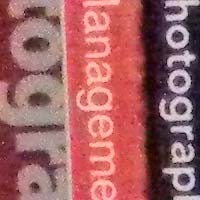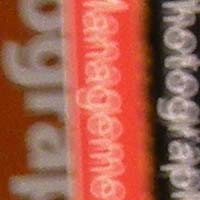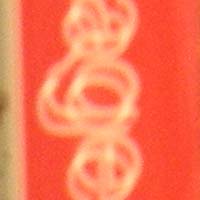Nikon Coolpix S60 Review
Review Date: March 6th 2009
Author: Mark Goldstein
Leave a comment about this review
|
Image Quality
All of the sample images in this Review were taken using the 10 megapixel High JPEG setting, which gives an average image size of around 4Mb.
Overall the Nikon Coolpix S60 produces good pictures. This camera's main drawback in terms of image quality is noise, with ISO 400 showing obvious noise and softening of detail. The noise, colour desaturation and loss of detail gets progressively worse as you go from ISO 400 to ISO 800 and finally the completely unusable 1600 and 2000 settings (with ISO 3200 being recorded at 5 megapixels). The Nikon Coolpix S60 handled chromatic aberrations excellently with limited purple fringing effects appearing only in high contrast situations. The 10 megapixel images were a little soft straight out of the camera at the default sharpen setting and ideally require some further sharpening in an application like Adobe Photoshop. The Nikon Coolpix S60's maximum shutter speed is 4 seconds, which is not great news for night photography enthusiasts, and the quality of the after-dark images is disappointing. Macro performance is below average too, allowing you to focus as close as 9cms away from the subject, with obvious barrel distortion evident. Vibration reduction is a very useful feature that sets this camera apart from its competitors and one that works very well when hand-holding the camera in low-light conditions or when using the telephoto end of the zoom range. The built-in flash worked very well indoors, with no red-eye and good overall exposure.
Noise
There are 9 ISO settings available on the Nikon Coolpix S60. Here are some 100% crops which show the noise levels for each ISO setting:
ISO 64 (100% Crop) |
ISO 100 (100% Crop) |
 |
 |
ISO 200 (100% Crop) |
ISO 400 (100% Crop) |
 |
 |
ISO 800 (100% Crop) |
ISO 1600 (100% Crop) |
 |
 |
ISO 2000 (100% Crop) |
ISO 3200 (100% Crop) |
 |
 |
Sharpening
Here are two 100% crops which have been Saved as Web - Quality 50 in Photoshop. The right-hand image has had some sharpening applied in Photoshop. The out-of-the camera images are a little soft at the default sharpening setting. You can't change the in-camera sharpening level.
Original
(100% Crop) |
Sharpened (100% Crop) |
 |
 |
 |
 |
File Quality
The Nikon Coolpix S60 has 2 different image quality settings available, with High being the highest quality option. Here are some 100% crops which show the quality of the various options, with the file size shown in brackets.
10M
High (4.10Mb) (100% Crop) |
10M
Normal (2.28Mb) (100% Crop) |
 |
 |
Chromatic Aberrations
The Nikon Coolpix S60 handled chromatic aberrations excellently during the review. Very limited purple fringing was mainly present around the edges of objects in high-contrast situations, as shown in the example below.
Example
1 (100% Crop) |
 |
Macro
The Nikon Coolpix S60 offers a Macro setting that allows you to focus on a subject that is 9cms away from the camera when the lens is set to wide-angle. The first image shows how close you can get to the subject (in this case a compact flash card). The second image is a 100% crop.
Macro Shot |
Macro Shot (100% Crop) |
 |
 |
Flash
The flash settings on the Nikon Coolpix S60 are Auto, Auto with Red-eye Reduction, Fill Flash, Flash On and Flash Off. These shots of a white coloured wall were taken at a distance of 1.5m.
Flash Off - Wide Angle (33mm) |
Auto Flash - Wide Angle (33mm) |
 |
 |
Flash Off - Telephoto (165mm) |
Auto Flash - Telephoto (165mm) |
 |
 |
And here are some shots of yours truly. As you can see, neither the Flash On setting orthe Red-eye Flash option caused any amount of red-eye.
Fill Flash |
Fill Flash (100% Crop) |
 |
 |
Auto with Red-eye Reduction |
Auto with Red-eye Reduction (100% Crop) |
 |
 |
Night Shot
The Nikon Coolpix S60's maximum shutter speed is 4 seconds, which is not great news if you're seriously interested in night photography. The shot below was taken using a shutter speed of 2 seconds, aperture of f/3.9 at ISO 64. I've included a 100% crop of the image to show what the quality is like.
Night Shot |
Night Shot (100% Crop) |
 |
 |
Vibration Reduction
The Nikon Coolpix S60 has a vibration reduction mechanism, which allows you to take sharp photos at slower shutter speeds than other digital cameras. To test this, I took 2 handheld shots of the same subject with the lens set to the same focal length and ISO speed. The first shot was taken with vibration reduction turned off, the second with it turned on. As you can see, with vibration reduction turned on, the images are definitely sharper than with vibration reduction turned off. This feature really does seem to make a difference and could mean capturing a successful, sharp shot or missing the opportunity altogether. Here is a 100% crop of the images to show the results.
| Shutter Speed / Focal Length | Anti Shake Off (100% Crop) |
Anti Shake On (100% Crop) |
| 1/7th sec / 33mm |  |
 |
| 1/4th sec / 165mm |  |
 |
|
![]() PhotographyBLOG
is a member of the DIWA
organisation. Our test results for the Nikon Coolpix S60 have been submitted to DIWA
for comparison with test results for different samples of
the same camera model supplied by other DIWA
member sites.
PhotographyBLOG
is a member of the DIWA
organisation. Our test results for the Nikon Coolpix S60 have been submitted to DIWA
for comparison with test results for different samples of
the same camera model supplied by other DIWA
member sites.
